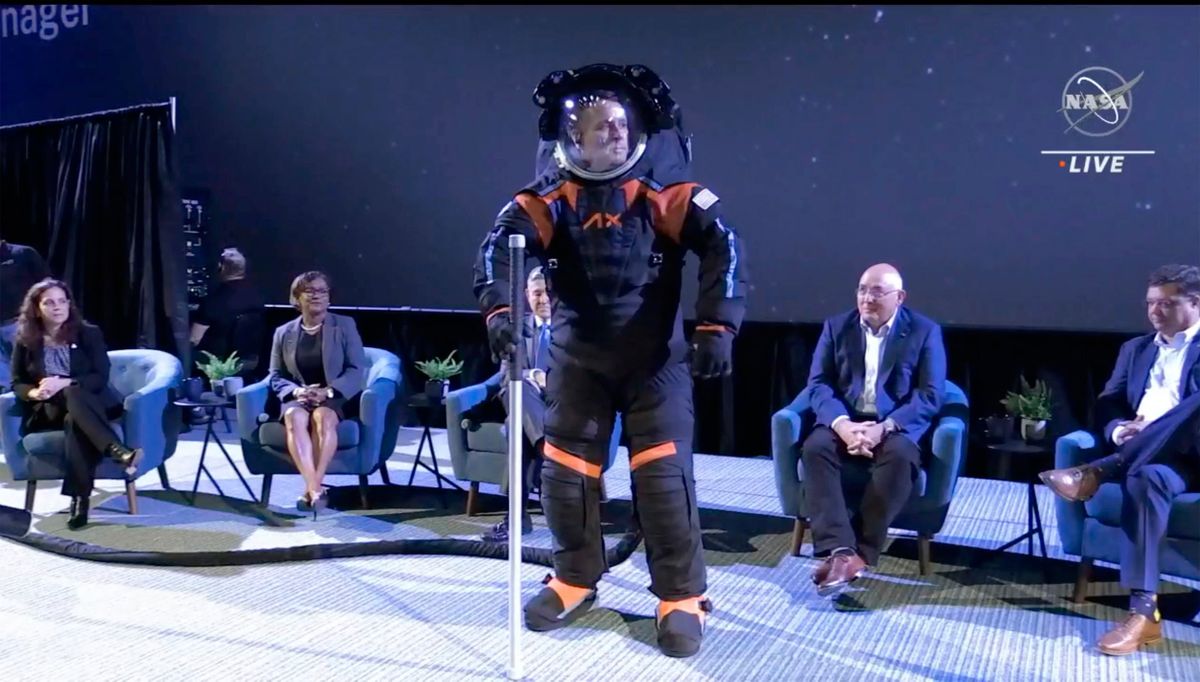NASA unveils a new moon suit for Artemis astronauts

In space, moon suits are the height of fashion, and NASA officials Wednesday lavished their highest praise on what astronauts will be wearing when they step on the moon in the coming years.
The latest in lunar spacewear – black with orange and blue highlights – comes from Axiom Space in Houston.
At an event in Houston unveiling the new suit, an engineer from Axiom who was demonstrating the lunar gear showed how he could easily squat and move around. The large clear bubble around the head provides wide visibility as well as lighting, which will be important when astronauts step into shadowed craters near the lunar south pole. It also has a mount for a high-definition camera. Astronauts will get into and out of the spacesuit via a hatch in the back side.
“You would put your feet in, put your arms in, and then kind of shimmy down into the suit,” said Russell Ralston, deputy program manager for extravehicular activity at Axiom Space. “And then we would close the hatch.”
On the back is a contraption containing the life support system.
“You can think of it as a very fancy scuba tank and air conditioner kind of combined into one,” Ralston said.
The main difference between the prototype shown Wednesday and what will be going to the moon is that the ones going to the moon will be white instead of dark.
“That’s really for thermal reasons,” Ralston said.
But the new suit may solve some larger issues. NASA astronauts Anne McClain, of Spokane, and Christina Koch were set to make history on March 29, 2019, as the first all-female crew to perform a spacewalk at the International Space Station. But NASA had announced that the spacewalk was delayed, “due in part to spacesuit availability on the station.”
The spacewalk that didn’t happen made international headlines as well as entertainment television. Saturday Night Live’s Aidy Bryant played a caricature of McClain.
The roughly three-minute sketch came during the Weekend Update segment. Host Michael Che told Bryant, playing a passive-aggressive and sarcastic version of McClain, that the news had to be disappointing.
“Nope. No. Not at all,” Bryant said. “No, I’m practical, I get it. Only one woman suit, so Christina did the spacewalk with my colleague Nick and they swam in the stars and they know what it is to be God looking down on the Earth. And me, me inside the window and it’s all OK.”
Bryant then went on to list McClain’s accomplishments in school, earning master’s degrees in aerospace engineering and international relations, and in the U.S. Army, including her career as a decorated major and combat pilot, “but then the space shirt and pants were the wrong size” and so the “dream gotta die.”
“Quite honestly, it was the laugh we needed up here,” McClain told the “Today” show.
The Artemis I mission will last about 30 days and will orbit around the moon. It will test the spacecraft system’s endurance against space-related environmental factors. Artemis I is the prelude to Artemis II, which will aim to take astronauts into the moon’s orbit in 2024. In 2025, Artemis III is set to launch and its goal is to put the first woman and first person of color on the moon.
“I’ve personally worked on various aspects of the mission from spacesuits to some of the displays and controls on the landers,” McClain told The Spokesman-Review last August. “But most of us are taking part in a lot of different training for these missions: geology, helicopters, all sorts of stuff.”
By turning to Axiom, a private company, NASA is again relying on new commercial space enterprises to provide key components faster and cheaper than it could itself develop.
The approach follows the template NASA used in hiring Elon Musk’s company SpaceX to get astronauts to and from the International Space Station and to the lunar surface on the mission for which the Axiom suits were designed.
The moon suit is a key component that is required for the Artemis program, which will be sending astronauts back to the moon as NASA faces heightened competition in space and on the moon from China’s booming space sector.
Axiom is led by Michael Suffredini, who previously served as NASA’s program manager for the International Space Station. The company has been primarily focused on low-Earth orbit, sending private astronauts to the ISS and building a private module to be added to the space station.
Spokesman-Review staff contributed to this report.